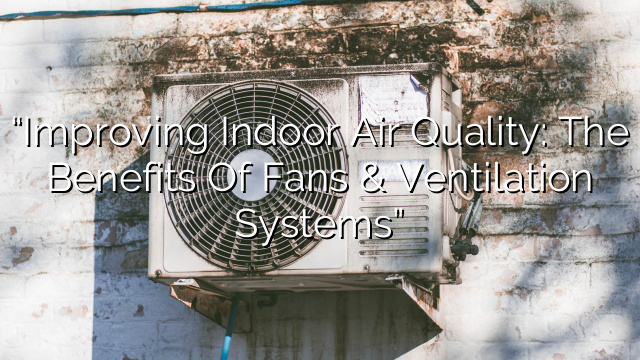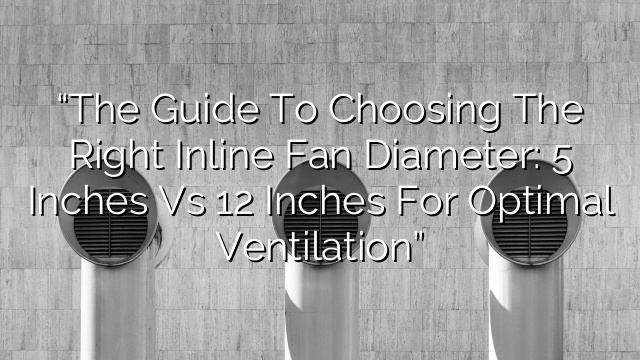Introduction
Fans & Ventilation, Inline Fans, Duct Axial Inline Fans Are you looking for an efficient way to improve the air quality in your home or business? Look no further than inline fans and ventilation systems. These powerful machines can help remove stale air, control humidity levels, and circulate fresh air throughout your space.
In this article, we will discuss everything you need to know about inline fans and ventilation systems. We will explore how they work, their benefits, and different types available in the market. Whether you want to improve the air quality in your home or enhance the ventilation in your commercial space, this article will guide you through the process.
How do Inline Fans and Ventilation Systems Work?
Inline fans are designed to be installed inside ductwork and operate by drawing air in or expelling it out. They can be connected to ducts or pipes to move air from one location to another. The design of these fans allows them to be highly efficient while taking up minimal space.
These fans are typically made up of a motor, propeller, and housing. The motor powers the propeller, which rotates and creates airflow. The housing encloses the motor and propeller, directing air through the ducts. Inline fans can operate standalone or be combined with other ventilation systems like HVAC systems or exhaust fans.
Benefits of Inline Fans and Ventilation Systems
Inline fans and ventilation systems offer a range of benefits, making them an essential component of any comprehensive air quality improvement plan. Here are some of the key advantages:
- Improved Air Quality: Inline fans help remove pollutants, allergens, and stale air from your space, improving the overall air quality. They can also regulate humidity levels, preventing the growth of mold and mildew.
- Increased Ventilation: By circulating fresh air into your space, inline fans promote better ventilation, ensuring a constant supply of clean air.
- Energy Efficiency: These fans are designed to be energy-efficient and can help reduce energy costs in the long run.
- Noise Reduction: Inline fans are typically quieter than traditional fans, making them ideal for residential and commercial spaces.
- Space-saving: Inline fans are compact and can be installed directly into existing ductwork, saving valuable space.
- Flexibility: Inline fans can be used in various applications, including bathrooms, kitchens, offices, warehouses, and more.
Types of Inline Fans and Ventilation Systems
There are different types of inline fans and ventilation systems available in the market. Choosing the right type for your specific needs will depend on factors such as the size of the space, air volume requirements, and noise restrictions. Let’s take a look at some of the most common types:
- Duct Axial Inline Fans: These fans are designed to be installed directly into the ductwork. They are ideal for applications that require high airflow and low pressure, such as exhaust ventilation in residential buildings.
- Centrifugal Inline Fans: These fans are suitable for applications that require high pressure and can overcome resistance. They are often used in commercial settings, such as offices or warehouses.
- Mixed Flow Inline Fans: These fans combine the characteristics of axial and centrifugal fans, offering a balance between airflow and pressure. They are versatile and can be used in a wide range of applications.
- Inline Duct Fans with Speed Control: These fans come with built-in speed control options, allowing you to adjust the airflow according to your requirements. They are often used in applications that require variable ventilation rates, such as grow rooms or hydroponic setups.
How to Choose the Right Inline Fan
When selecting an inline fan for your ventilation system, several factors need to be considered:
- CFM Requirement: Determine the required airflow in cubic feet per minute (CFM). This will depend on the size of the space, the number of air changes per hour needed, and specific ventilation requirements.
- Noise Level: Consider the noise restrictions in your residence or business. Look for fans with lower decibel (dB) ratings for quieter operation.
- Energy Efficiency: Check the fan’s energy efficiency rating to ensure it won’t significantly increase your energy costs.
- Installation: Consider the available space and the ease of installation. Some fans may require professional installation, while others can be DIY projects.
- Warranty and Customer Support: Look for fans with a warranty and reliable customer support, in case any issues arise.
Frequently Asked Questions (FAQ)
Q1. Can inline fans be used with existing ventilation systems? Yes, inline fans can be easily integrated into existing ventilation systems. They can be installed in line with the ductwork to enhance the airflow and improve the efficiency of the system.
Q2. What maintenance is required for inline fans? Inline fans require regular cleaning to prevent the buildup of dirt and debris. Check the manufacturer’s instructions for specific cleaning guidelines. Additionally, inspect the fan periodically to ensure proper functioning and replace any worn-out parts.
Q3. Are inline fans suitable for residential use? Yes, inline fans are commonly used in residential settings. They are particularly useful in areas with poor ventilation, such as bathrooms and kitchens, where they can help remove odors, excess humidity, and improve air quality.
Q4. Can inline fans be used in commercial spaces? Absolutely! Inline fans are widely used in commercial spaces, including offices, warehouses, retail stores, and restaurants. They can improve ventilation, control temperature, and enhance air quality in these environments.
Q5. Can inline fans be used for odor control? Yes, inline fans are highly effective for odor control. By continuously removing stale air and introducing fresh air into the space, they can help reduce unpleasant odors.
Conclusion
Inline fans and ventilation systems are a reliable and efficient way to improve air quality, control humidity, and maintain optimal ventilation in any space. Whether it’s a residential or commercial setting, these fans offer numerous benefits such as improved air quality, increased airflow, energy efficiency, and noise reduction.
When choosing an inline fan, consider factors such as CFM requirements, noise levels, energy efficiency, and installation ease. By selecting the right inline fan and ensuring proper maintenance, you can enjoy clean, fresh air and a healthier living or working environment.














